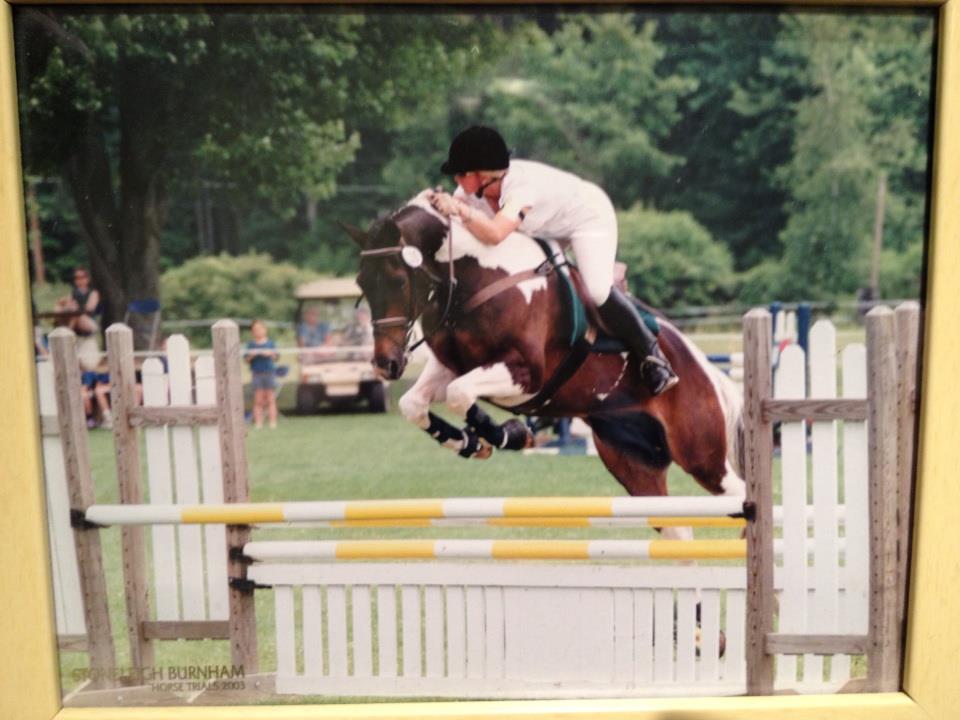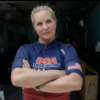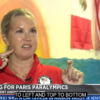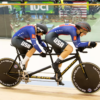It’s hard to believe that a mere six years ago I was preparing for my annual trip to Ocala with my beloved eventer, Calico. Blankets were washed, bodies were being clipped, my rig was tuned up, and endless hours of preparing for our dressage test were logged under saddle. Fast forward to December 2012, and I’m navigating the sidewalk with my new 4-legged companion, Elvis, a yellow Labrador Retriever who now serves as my guide and my eyes. We are traveling downhill towards the train station, en route to a meeting, and I give a half-halt on the rigid guiding harness to slow him down from our blistering pace. “Easy”, I tell him soft and low. I catch myself sometimes saying, “whoa” or clucking to get him moving or refocused. A bad habit, I tell myself, from more than three decades spent in the saddle riding eventers, showjumpers, and dressage horses. I laugh out loud, happy that I sometimes make that mistake with Elvis, but a little melancholy for those days flying through the woods, watching the trees whiz by as we clear logs, stone walls, and large gates. Now even finding a door knob seems a major accomplishment, and making it safely across a busy intersection on foot is cause for a mini celebration with my trusty guide.
I was diagnosed with a rare eye disease in my early twenties, and was told that eventually it would lead to inevitable blindness. My vision straight ahead was 20/20, but with each new attack of my disease, my field of vision would become narrower and narrower, eventually fading to nothingness. Determined to live out my life’s dream of becoming a professional equestrian, I digested this diagnosis and went on with my life. I had the good fortune of owning a scopey, brave Paint Thoroughbred/ Dutch Warmblood who was left to me by my father. He was as green as could be, but I was relentless in my pursuit of perfection with him, and he obliged by being a willing, fun, and talented student.
My vision was in a constant state of ebb and flow, depending upon the lighting, my blood pressure, and a variety of factors. I realized quickly that ‘riding by feel’ was not only important, it was essential to my safety and Calico’s. I practiced daily over ground poles to compensate for my constantly changing depth-perception. My ability to ‘feel” and not just “see” a distance to a fence made jumping natural obstacles in the woods effortless despite my vision impairment. The only time I really struggled with my disease while riding was in the warm-up area, where riders and horses milled about in no apparent pattern. In eventing, our warmups are usually in an open field with two single fences set up, so generally there’s lots of room for everyone.
At one particular event, I had the misfortune of literally bumping into my idol, Karen O’Connor. She was competing against Calico and I on a young horse she was bringing along in the Open Training division. I was busy focusing on my leg yields across the field, and managed to slam right into her and the lovely Bay Thoroughbred she was riding. Horrified, I apologized, and quickly moved out of her way. Again, I came across the diagonal, and this time accidently caught her leg with my dressage whip, to which she tersely but politely said, “I seem to be getting in your way,” with a smile as she trotted off to a more remote part of the field. I stared desperately at my trainer, about to burst into tears with frustration and embarrassment. Dean quickly trotted over to Karen and explained my impairment to her, at which she looked my way, tipped her hunt cap, and smiled. “She is a class act all the way,” I thought to myself.
As Calico and I graduated up the levels from Beginner Novice up to Preliminary, it became evident that the fences were not our biggest challenge; it was dressage. I had the good fortune of living across the street from Lendon Gray’s farm in Bedford NY, where I rented a cottage and a two stall barn. Lendon was incredibly generous to me although I was newly out of college and in an incredible amount of debt. She let me use her ring to practice, and her luxurious heated wash stalls in the winter after a tough lesson or school. I had ridden Maclay as a Junior, so my position was exemplary, but what made the magical difference was the way in which Lendon explained to me WHY and HOW weight distribution and the position of my seat bones and shoulders could so drastically affect my horse’s performance and balance. The light bulb suddenly went off. After months of working tirelessly in the ring on our leg yields, she pulled me aside and gave me some of the best advice I’ve ever received. “Your poor horse simply doesn’t have the strength in his hind end to give you a consistent leg yield. Get the heck out of my ring and go and do what you two do best- ride cross country! I don’t want to see you back in here for 4 weeks. During that time, ENJOY your horse! Ride those hills up and down over there; go jump some logs. Maybe ask for a mini-leg-yield on the trail. But under NO circumstances do I want to see you in your dressage saddle! Go be an eventer!” and with that, she patted Calico on the rump, and off we went. Flying through the trees, up the banks of the riverbed, over the stone walls that lined the great estates in Bedford NY. We were free!
Four weeks later, I returned to the ring to test her theory. We picked up a medium-trot, and turned up the centerline of the outdoor ring. I asked for a little inside bend, and gently rotated my seat bones. Within seconds, I found myself at the far corner of the ring, where I was snapped to attention by a boisterous, “Atta girl!” from Lendon, who had been walking past the arena. “What did I tell you?” she smiled.
Training with a guide dog is like learning to dance, and a whole new language at the same time. In other words, it’s like dressage! Like jumping, you need your head level and looking in the direction of your target, like headlights on a car. Like dressage, the communication is at its best when it’s invisible and delicate- a silent language between dog and handler or rider and horse. In the beginning of both endeavors, you experience setbacks, mistakes, and miscommunication. It is the intelligence of these wonderful animals that allows us to make these mistakes, but then come out another day even better for them.
Like riding dressage, one’s position is essential in obtaining the best performance from my dog. When I began training with Elvis after he had been with a professional for two years, it was like getting the reins to a big fancy Grand Prix Horse that was still young and fresh. He was easily distracted. If I didn’t ask the right thing in the right way, we would accidentally do a pirouette on the spot, unintentionally landing exactly where we started. But always, always, he would be there on my left heel, looking expectantly up at me, and awaiting anxiously and enthusiastically the next command or destination. It’s like the horse that literally “lights up” when you step into the arena with him. The roar of the crowd, the crackle of the loudspeaker- he knows it’s all for him, and he wants to perform. A young guide dog is like that- full of promise, training, and potential- a high performance living, breathing machine. It’s learning to dance together that provides the greatest challenge.
The first six months I literally felt “over-mounted”, like Elvis was some 17 hand Swedish Warmblood that I had no clue how to ride. His pull was extremely hard, and my shoulder and triceps were on fire each night. His pace was so quick that I had to nearly trot to keep up, and he would do his job so precisely and accurately that I was nearly breathless with awe. A low and soft command of “easy” and he would nearly grind to a halt. A command of “hup-up” (equal to a cluck) would mean he would take off at an astonishing pace.
Where the beauty began was in those “mini-seconds” where my shoulders were square, my eyes were up, and Elvis would suddenly be light in the harness (like your snaffle rein), with the softest of contact with the leash (which works like a curb rein). It took about six hard months before I had one of these moments. But they were there. And with each passing week the moments would last longer, and there would be more of them. The light bulb went off. I remember Lendon saying, “Practice does not make perfect. Only perfect practice does.” She was so right. By sticking to our training, maintaining my position, and being relentlessly consistent, I had achieved Guide Dog Grand Prix status. More and more, the communication flowed seamlessly. Our walks and travels were effortless. When mistakes were made, only the slightest “half-halt” or leash correction was needed. I could say commands like, “find the garbage; hit the button (for the crosswalk); or find the train, and we would arrive at the train station within minutes. I could merely think things, such as, “Gee, I’d better start getting my coat on as we’re approaching our bus stop” and Elvis would already be standing at attention in a text-book-like heel at my side, awaiting my hand on the harness handle.
Trips to the Yale Eye Clinic became routine for him. He could effortlessly guide me the eight blocks through noisy and erratic construction, from the train station to the hospital, through the sliding doors, to the elevator, then down the long corridors to the office, evading wheelchairs, children, potted plants and the janitor’s cleaning cart without batting an eyelash. It reminded me of the early days of training with Calico, where those “moments” would happen for only a stride or two, but you FELT it. You KNEW that’s what you were striving for, and got a taste of what it COULD be like, if you were willing to put the time in, and be good to your horse and patient with the process.
While for years my life and safety depended upon the bravery and scope of my horse while on Cross Country, I never imagined that an animal 1/10th Calico’s size could save and protect me on a daily basis from everyday hazards and obstacles. I always believed that the bond we have with our horses, through the thousands of hours in the saddle, the astronomical bills, the nights spent sleeping on hay bales during colic scares, and the quiet moments during grooming and grazing was never to be filled by another partnership. I stand corrected. The love and appreciation I see reflected back at me through my Guide Dog is the closest thing I can ever imagine to feeling truly safe and honored. Those moments where you achieve lightness and fluidity, bouncing along the sidewalk, with no sound but the jingling of his dog tags, I know I’ve found my other sacred partner. While it may not be the jingling of your stirrups and that feeling of weightlessness as you reached the arc of your jump, it is the closest I have ever felt to any animal, and I have never been more grateful to have this wonderful blessed partner in my life.





Nice post! Your vision sounds like it progressed similarly to mine. I’ve been with my guide dog for about 6 months now and although she still gets really distracted by other dogs, it is quite an amazing feeling to have total and complete trust in a dog. They do teach us quite a lot don’t they?
Thanks Carrie! Where is your dog from? Elvis is from Guiding Eyes for the Blind in Yorktown NY. Don’t worry- about 6 months into working with your dog, it just suddenly “clicks”. I also transitioned from the choke collar to a pinch when I knew there would be heavy dog distractions present for better control
Casey is from Guide Dogs for the Blind, Oregon campus near Portland. I love her, she is amazing and so much more fun than a cane!
Great description! I always wanted to ride, but couldn’t afford it in my teens and the dream withered away. I trained my hearing dog and we got into the dressage (which I love) moves, freestyle. He does some basic traffic guiding and has yes, pulled me out of the path of incoming cars and checked me or directed me to the curb in time to evade unseen cars coming around corners or behind hills. It has been extraordinary. And yes, he’s the pony I never had.
kudos to you for sticking with riding/eventing. Not an easy sport as you lose your sight. I have a juvenile form of macular degeneration. So slow loss of central vision and my right peripheral is going as well. While I did gaming with my mare I had hopes to event.. Still plugging away at the dressage. Trying to quiet down the mare at a show ground atmosphere has been “interesting.”We still do some gaming cause well my mare loves to run and jump. While riding cross country she is like a kid in a candy shop. She takes very good care of me. I direct the path and she decides the rest (sometimes trying to through in an extra jump when she thinks it looks fun) Since my eyesight has been a slow decrease my mare has slowly adjusted to what I loose. While we wil never go above BN we have fun and still sneak in a novice log once in awhile.
I’m a rider and am getting my first service dog next month, and one of my criteria was “must not be completely freaked out by horses” I have a feeling I will have trouble not giving the poor dog horse commands for awhile…
Elvis, my guide dog is fascinated by horses, but not very savvy around them sadly. He walks righ underneath them, which is obviously very dangerous and my horse DOES NOT like dogs one bit!